I’ve been a SAFe® Product Owner (PO) for two years and I’ve learned that showing up well in this role is more than just a skill set you build. It becomes an art that deserves practice, consideration, professional development, and your authentic personality.
As a PO of a very busy team that is charged with understanding and delivering on customer journeys with SAFe learning content, my daily work life can include:
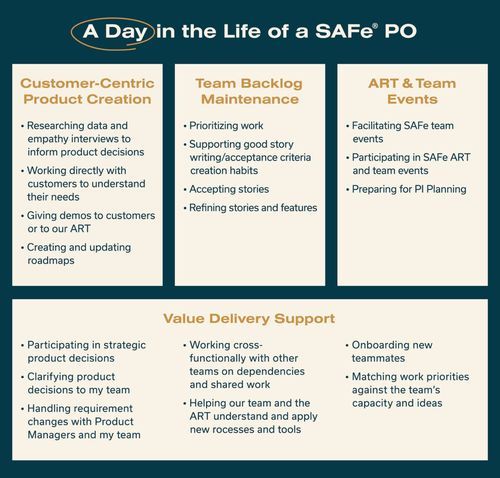
See formal guidance on the PO role in the PO Framework article.
In short, my day can hold many twists and turns. Over the last two years, I’ve developed some habits and practices that help me bring my best self to this role as often as possible:
- Treat the work as an important teammate
- Treat yourself as an important teammate
- Know whose opinions matter most to you
- Practice setting boundaries
- Form a great bond with your team’s Scrum Master/Team Coach
In the following sections, I’ll explain these practices in more context and share resources to help you accomplish them on your team.
SAFe® Product Owner Tip One: Treat the Work as an Important Teammate
POs often face competing priorities, needs, and opinions.
This means I may hear from someone in one part of the organization why we need X and then hear from someone on my team why X is a terrible idea. I can learn why someone desires to work on something new and learn why we won’t be pursuing that idea in the same hour. I often do.
One way I resolve this is to treat the work as a teammate that deserves respect, care, and consideration.
Here’s an example of how this works.
A high-performing team member shared she was interested in enabler work towards researching and selecting upgraded tools. However, her work in the upcoming PI was heavy in iterations one, two, and three. This planned work was for committed deliverables in iteration four.
Architecture also approached me to help get alignment on having that team member work with them on this tool selection. They proposed several longer-than-average meetings with this team member in iterations one, two, and three as well as asking for exploration work from this team member in iterations three, four, and five.
I knew my team member was invested in choosing the right future tool for our work. I also knew we would miss our PI objectives and delivery of products without the crucial work she was planning in the early part of the PI.
I thought of my teammate and the work as equals, having needs and deserving a thoughtful decision. I worked with Architecture and the teammate to craft expectations for this PI and an extended timeline for the enabler work so the team’s work, the teammate, and Architecture all had a path forward.
SAFe Product Owner Tip Two: Treat Yourself as an Important Teammate
SAFe Product Owners and Scrum Masters/Team Coaches have specialty roles AND are a part of the team. This can be confusing sometimes. Should you add items to the team retro or vote in estimating poker? What happens when you have a family emergency or take vacation? Can you plan stories?
Having a different title or being a decision-maker can serve to distance you from teammates. In my first two PIs as a PO, I felt this keenly and decided to think about it differently.
My skills help the team deliver value and understand who will consume it and what they need. Once I started thinking about myself as a contributor rather than a “distanced person with a different role,” it made it much easier to decide: Yes, and.
- YES, I should add items to our Team’s iteration retrospective! AND maybe I should mind my airtime and let others go first when the team is discussing which actions or changes they’d like to pursue in the next iteration.
- YES, when we take team assessments such as the Team and Technical Agility assessment, my voice matters, AND if I have areas of disagreement, I’ll wait for my Scrum Master/Team Coach to facilitate conversations.
- YES, I can vote in estimating poker when we’re sizing stories, AND if the person doing the work has a strong feeling or the rest of the team disagrees with my estimate, I’ll cede my opinion.
- YES, I can take a long vacation AND find ways for my team to move stories through our Kanban while I’m unplugged.
- YES, I can write stories! If there are areas of expertise I can leverage to help us develop our products, I can and should write stories! AND, when I have the opportunity to learn more about how others on the team are completing work, this builds my T-shaped skills and helps me plan work on our team with more knowledge and empathy.
Since making this shift, I’ve become more equipped to
- Know what work we’re doing
- Understand the how and why
- Help our team reach out cross-functionally in the ART or to work with customers
Our team has been on a high-performing trajectory since this shift. While correlation isn’t causation, I intend to continue this mindset.
SAFe Product Owner Tip Three: Know Whose Opinions Matter Most to You
I like to joke about what I do for a living because (let’s be honest) parts of my family struggle to understand what I do at work. Sometimes I tell people I solve problems just-in-time for a living. Sometimes I tell people I negotiate and set boundaries for a living. Often I tell people I make someone unhappy nearly every day for a living.
Making people unhappy is one of the hardest parts of being a SAFe Product Owner. Because I’m involved in a team executing product development, maintenance, and delivery while acting as an interface with other teams we need work from or need work from us as they execute, misaligned needs and timing will arise.
Every decision I make, negotiate, share, or support, can potentially frustrate a teammate, someone on another team, someone on the extended product team, our business owners, or any combination of these folks.
People’s work is personal. This is their career, their time away from their family, their commitments, and the products they love and use. Their feelings about work are valid.
I’ve learned to accept and sit closely with someone having uncomfortable feelings about a decision. I put intense work into validating feelings, no matter how strong they may be and regardless of my agreement about that person’s wishes or ideas.
It can be challenging to stay calm with someone in an emotional situation. This is even harder to do without talking them out of their experience. I can’t do it unless I hold deep and important knowledge—I’m ok even if people disagree with me today. Not everyone’s opinions of me need to shape me in every moment.
I extend unconditional positive regard for people while building a working relationship with them. I assume good intent. And after that, the people who really stick with me respond to my brand of being me and getting work done.
This means I can live with some people who are unhappy with the news, decision, or strategy I’ve just shared. I can stay calm, professional, and empathetic without agonizing over the interaction.
It may sound like I care less about some people. However, what results from this approach is room for me to care deeply about the people I work with most frequently and maintain room for my own work, their needs, and new work relationships to grow.
Early in my life as a PO, carrying everyone’s thoughts and feelings kept me up at night and sometimes prevented me from saying things that needed to be said.
Rejecting this mindset has made me a better, more decisive, and more reliable PO.
SAFe Product Owner Tip Four: Practice Setting Boundaries
SAFe Product Owners often need to tell their team, Product Manager, an engineer or architect, other teams, ART, or Business Owners “no.” No feels like such a scary word. No can sit on the tip of my tongue and raise questions like, “Will this cause anger? Disappointment? Personal dislike?”
In the end, saying no to some things allows teams to say yes to others, and to take meaningful action on those commitments. It’s what allows us to create quality products. Conversely, saying yes to everything leads to poor quality, missed commitments and objectives, and personal and professional disappointments.
I decided to take a deep dive into setting boundaries. I started by considering how I could say “no” or “maybe” with clarity.
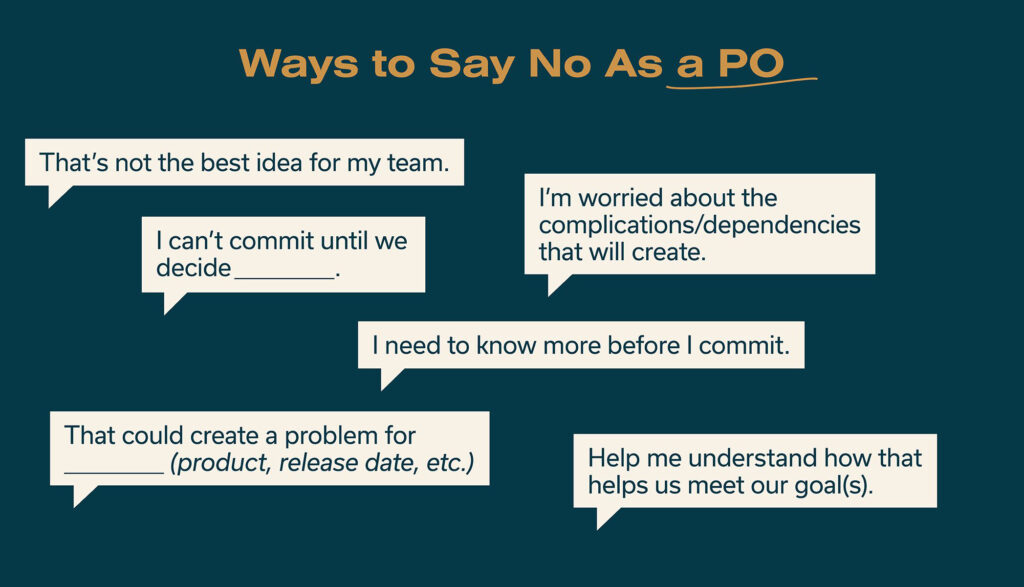
These are a few of the ways I trained myself to respond so I could communicate boundaries without shutting down necessary conversations.
For some time, I had these on a sticky note on the wall behind my desk. I rehearsed them and queued myself to remember to use these phrases.
After several PIs, my team started asking how I got so measured and productive at setting boundaries. We now brainstorm as a team ways to set boundaries before we go into PI planning. Here are some of the boundary-setting phrases our team has come up with:
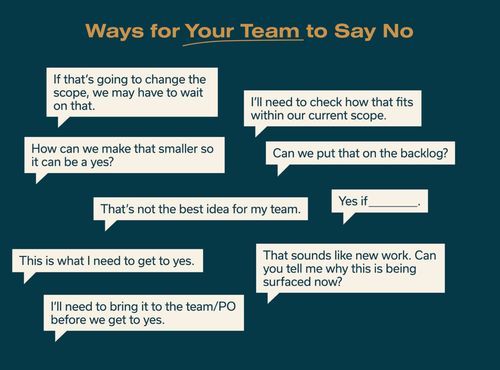
The truth is these phrases are useful outside of PI planning throughout iterations. The bigger truth is they’re helpful in day-to-day life outside of work.
SAFe Product Owner Tip Five: Form a Great Bond with Your Team’s Scrum Master/Team Coach
I am lucky to have the kind of relationship with my team’s Team Coach where we happily grab taco dinners together. I don’t think all POs must be buddies with their teams’ Scrum Masters/Team Coaches. But it does help the work and team for POs to have good working relationships with the person in this role on the team.
As a SAFe Product Owner, you have your eyes on the needs of the customer (i.e., anyone who consumes your team’s work) and the work. I like to say, “I’m not the boss of anyone. I represent the work.”
The Scrum Master or Team Coach has their eyes on team performance, work progress, and delivery. I’ve found that having a great working relationship with the Team Coach on my team means we can coordinate to support the team and work and fine-tune our team and technical agility.
Ways I’ve coordinated with my Team Coach to support the team include:
- Proposing breaking our Agile team events up differently
- Devising ways to handle things asynchronously when we have scheduling traffic jams
- Asking me powerful questions when I’m facing hard decisions on priorities and moving the work forward
I can also go to our Team Coach and propose agenda items for our team events, ask for help getting data and metrics, and collaborate on thinking through team challenges and needs.
It’s so rewarding to have a relationship with our Team Coach where I can talk candidly about where we’ve been as a team, where we’re headed, and the ways we can both leverage our skills and perspectives to help the team succeed.
This makes it enjoyable to collaborate on planning team celebrations. We’ve worked together to coordinate
- A “game show”-themed gathering
- Gift bags
- Creative ways for the team to learn about one another and appreciate each other more
- A remote cookies and hot cocoa gathering
- Team meals
By far, the best part of working so well with my Team Coach is that we can support and challenge each other. When my Team Coach had a professional development goal to become an SPC and SAFe Trainer, I covered team events and cheered him on.
Likewise, he got creative with ideas for story acceptance and team events I usually handle so I could take a long vacation.
We also push each other to look at our team’s metrics, consider new ways to engage the team in Agile team events, share successes and improvements with the ART, and share our talents beyond the team level.
In this relationship, each of us has grown into our roles and pushed ourselves and each other. The team has also been recognized as high-performing in qualitative and quantitative ways.
Enhance These Tips with Some PO Resources
I hope including these tips, practices, and mindsets helps you consider your own development as a PO and how your work positively impacts your team’s work. Lean into the art of being a PO in your own way as you try some of these ideas out:
Videos
Blogs
- Three Lessons I Learned in My First Year as a Product Owner
- What’s a Product Owner to Do
- Product Owners, Product Managers, and the Feature Factory
- Why the Most Successful PMs and POs Share a Brain
- POs and PMs: A Dynamic Duo
Assets
- Facilitator’s Guide to SAFe: Iteration Planning
- Facilitator’s Guide to SAFe: Backlog Refinement
- Facilitator’s Guide to SAFe: PO Sync
- Facilitator’s Guide to SAFe: ART Sync
- Story Mapping Support template
- Story Splitting template
- PO Community Forum
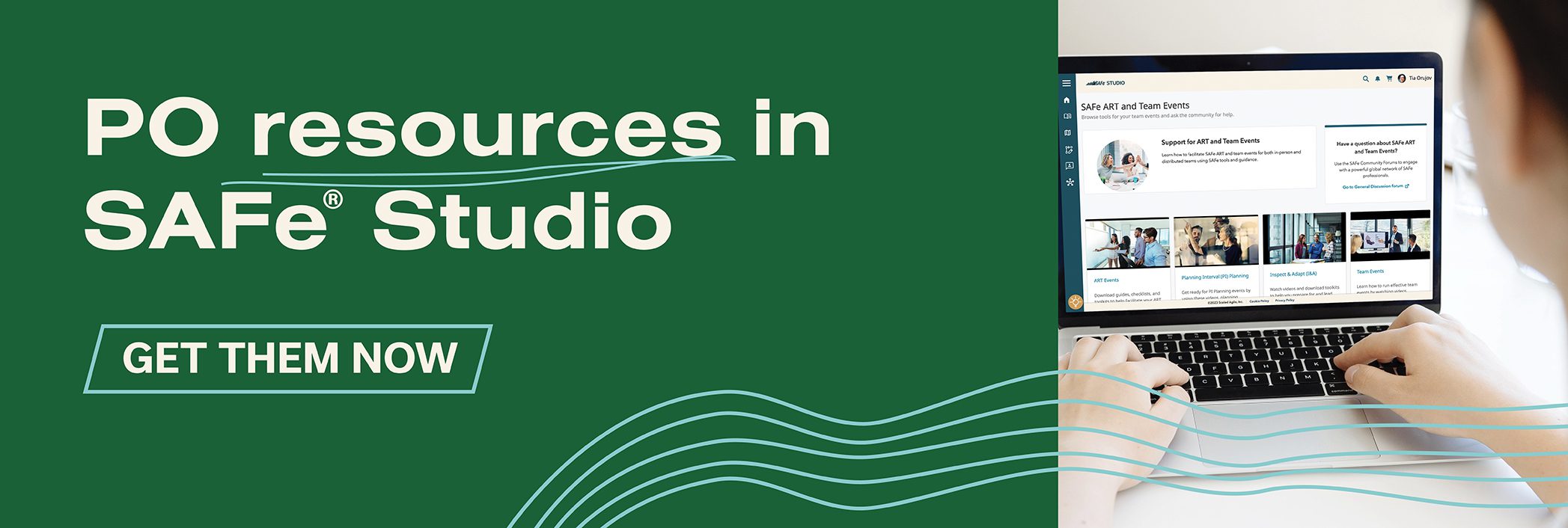
About Christie Veitch
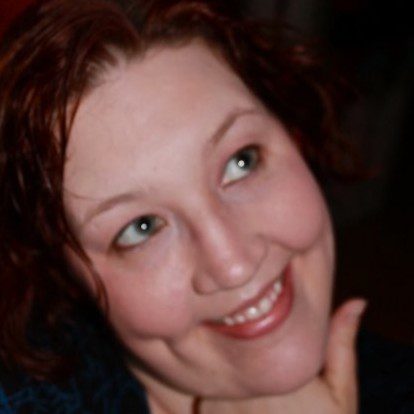
As a writer and education nerd who loves processes, Christie seeks to move the needle on what learners can do and what educators and trainers will try with learners. She designs and delivers compelling content and training and builds communities of avid fans using these resources as a Scaled Agile, Inc. Product Owner. Connect with Christie on LinkedIn.